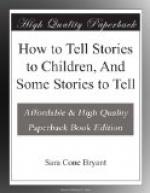Now of course I had known all along that the humour of the story emanated from its very exaggeration, its absurdly illogical smoothness. But I had not felt it. I did not really “see the joke.” And that was why I could not tell the story. I undoubtedly impressed my own sense of its fatuity on every audience to which I gave it. The case is very clear.
Equally clear have been some happy instances where I have found audiences responding to a story I myself greatly liked, but which common appreciation usually ignored. This is an experience even more persuasive than the other, certainly more to be desired.
Every story-teller has lines of limitation; certain types of story will always remain his or her best effort. There is no reason why any type of story should be told really ill, and of course the number of kinds one tells well increases with the growth of the appreciative capacity. But none the less, it is wise to recognise the limits at each stage, and not try to tell any story to which the honest inner consciousness says, “I do not like you.”
Let us then set down as a prerequisite for good story-telling, a genuine appreciation of the story.
Now, we may suppose this genuine appreciation to be your portion. You have chosen a story, have felt its charm, and identified the quality of its appeal.
You are now to tell it in such wise that your hearers will get the same kind of impression you yourself received from it. How?
I believe the inner secret of success is the measure of force with which the teller wills the conveyance of his impression to the hearer.
Anyone who has watched, or has himself been, the teller of a story which held an audience, knows that there is something approaching hypnotic suggestion in the close connection of effort and effect, and in the elimination of self-consciousness from speaker and listeners alike.
I would not for a moment lend the atmosphere of charlatanry, or of the ultra-psychic, to the wholesome and vivid art of story-telling. But I would, if possible, help the teacher to realise how largely success in that art is a subjective and psychological matter, dependent on her control of her own mood and her sense of direct, intimate communion with the minds attending her. The “feel” of an audience,—that indescribable sense of the composite human soul waiting on the initiative of your own, the emotional currents interplaying along a medium so delicate that it takes the baffling torture of an obstruction to reveal its existence,—cannot be taught. But it can and does develop with use. And a realisation of the immense latent power of strong desire and resolution vitalises and disembarrasses the beginner.




